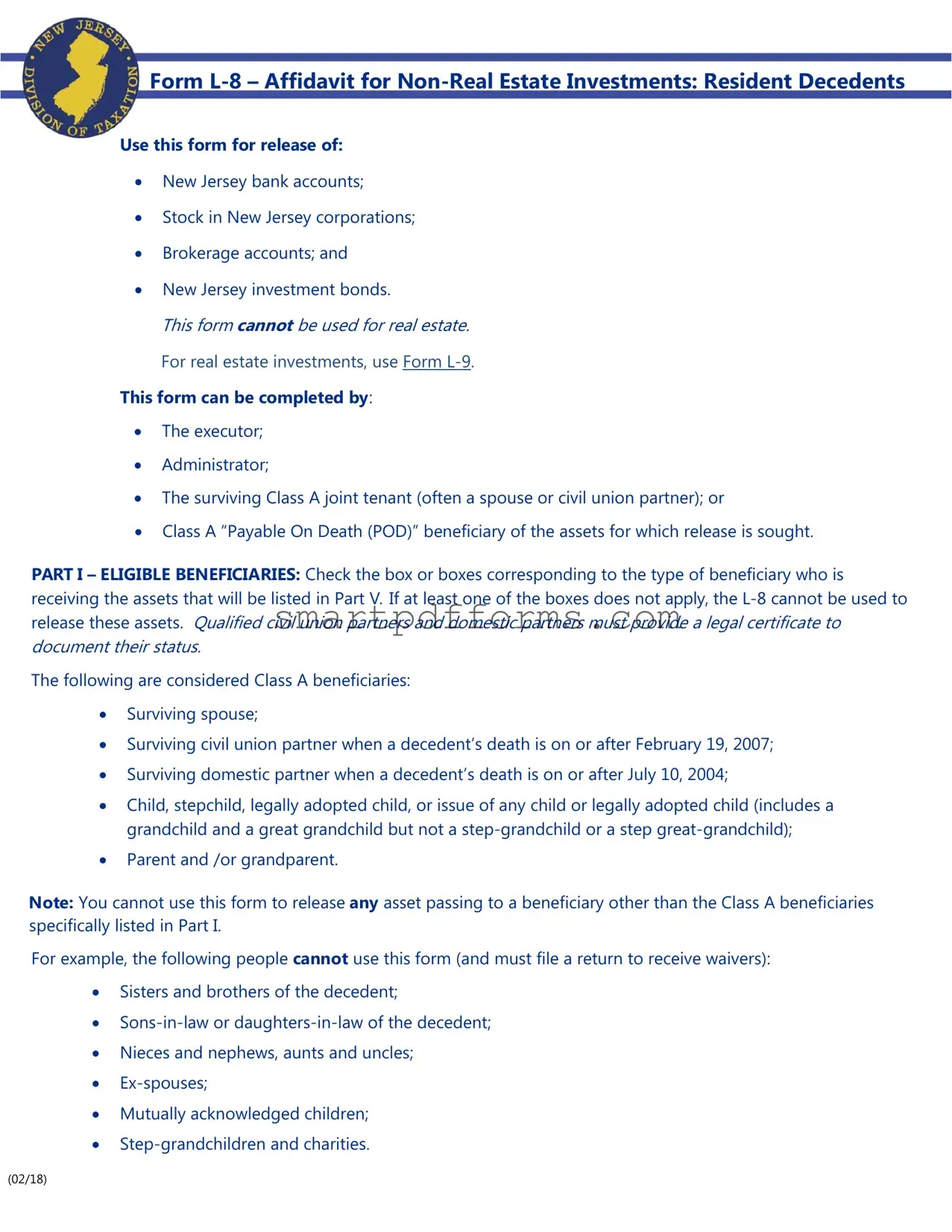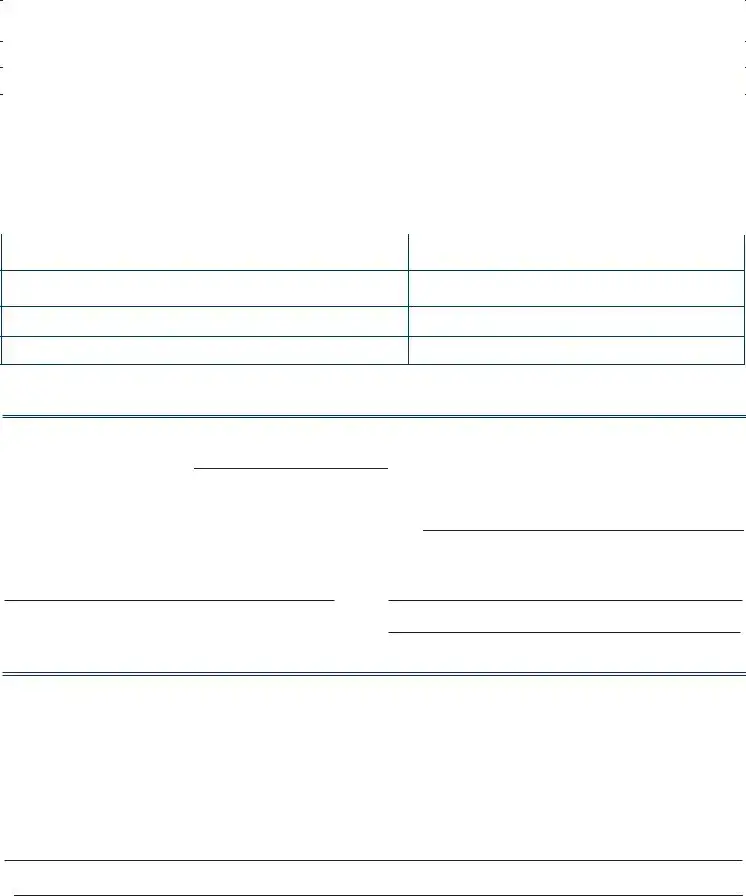
Form L-8 – Affidavit for Non-Real Estate Investments: Resident Decedents
Use this form for release of:
New Jersey bank accounts;
Stock in New Jersey corporations;
Brokerage accounts; and
New Jersey investment bonds.
This form cannot be used for real estate.
For real estate investments, use Form L-9.
This form can be completed by:
The executor;
Administrator;
The surviving Class A joint tenant (often a spouse or civil union partner); or
Class A Payable On Death (POD) beneficiary of the assets for which release is sought.
PART I – ELIGIBLE BENEFICIARIES: Check the box or boxes corresponding to the type of beneficiary who is receiving the assets that will be listed in Part V. If at least one of the boxes does not apply, the L-8 cannot be used to release these assets. Qualified civil union partners and domestic partners must provide a legal certificate to
document their status.
The following are considered Class A beneficiaries:
Surviving spouse;
|
Surviving civil union partner when a decedent’s death is on or after February |
, |
; |
|
Surviving domestic partner when a decedent’s death is on or after July , |
4; |
|
Child, stepchild, legally adopted child, or issue of any child or legally adopted child (includes a grandchild and a great grandchild but not a step-grandchild or a step great-grandchild);
Parent and /or grandparent.
Note: You cannot use this form to release any asset passing to a beneficiary other than the Class A beneficiaries specifically listed in Part I.
For example, the following people cannot use this form (and must file a return to receive waivers):
Sisters and brothers of the decedent;
Sons-in-law or daughters-in-law of the decedent;
Nieces and nephews, aunts and uncles;
Ex-spouses;
Mutually acknowledged children;
Step-grandchildren and charities.
PART II – SUCCESSION: Check the box that shows how the assets pass to the beneficiary.
Check Box a if the assets on the form pass directly to the beneficiary by operation of law. This means they were jointly held, POD, or Transfer on Death (TOD). (A copy of the will is not needed);
Check Box b if the will states that these specific assets reported on the L-8 form pass to a particular named beneficiary. (Attach a copy of the will);
Check Box c if there was no will (intestate) and all the beneficiaries in the entire estate are Class A beneficiaries as listed in Part I; or
Check Box c if there was a will (testate), but there were no specific bequests and all the beneficiaries in the entire estate are one of the Class A beneficiaries listed in Part I (attach a copy of the will).
Note: If at least one of the boxes does not apply, the L-8 cannot be used to release these assets.
PART III – TRUSTS/DISCLAIMERS: If any of the assets you wish to release pass into or through a trust, where the
trust decides how the assets are distributed, you cannot use the L-8. Trusts can be set up by decedents either in their will, or separately from the will. For the purposes of the L- , it is not generally considered a trust when there is a bequest in the will to a minor who is a Class A to be held in trust until he/she reaches a specific age. In all other
cases, a full return must be filed with the Inheritance Tax Branch, even if the assets all appear to be passing to Class A beneficiaries.
NOTE: Assets that are owned by or in the name of a trust do not require a waiver or L-8, but must still be reported on any return filed.
PART IV – ESTATE TAX: This section determines whether the estate may be required to pay New Jersey Estate Tax. You must be able to answer YES to either a , b , or c) to qualify to use this form. If the decedent died on or after
January 1, 2017, but before January 1, 2018, his/her entire taxable estate must be under $2 million. If the date of death was before January 1, 2017, the entire taxable estate must be under $675,000. Even if you qualify to use this form, a return is still required if the gross estate is over $675,000. If the decedent died on or after January 1, 2018, then there is no Estate Tax.
PART V – PROPERTY: List all the assets in this institution for which you are requesting a release. If this is a bank, list each account in this bank separately. Follow the column headings for each asset. Under How held/Registered, you may enter NOD Name of Decedent if the account was in the name of the decedent alone. If it was Paid on Death POD to a person, enter POD to and the person or persons’ names (e.g., POD Jane Doe and John Doe). If it was jointly held, enter NOD and/or the beneficiary’s name.
PART VI – BENEFICIARIES: List the name of each beneficiary and his/her relationship to the decedent. The relationship must be one of the Class A beneficiaries listed in Part I of the L-8.
NOTE: Executor, Estate, and |
Beneficiary are not correct relations to the decedent in this column. You must use |
terms such as Child, Spouse, |
or Grandchild. |
SIGNATURE: This form is an affidavit and must be signed by the executor, administrator, or beneficiary, and the signature must be notarized.
PART VII – RELEASING INSTITUTION: A representative of the institution releasing the funds must verify that all questions have been answered and that the beneficiaries reported are allowed per Part I, before signing the form and releasing any assets. If you have any question as to whether you are permitted to release assets, please call the Inheritance Tax general information number at (609) 292-5033 and ask to speak to an Information Section representative.
Form L-8
Take or send the completed form directly to the bank or other financial institution holding the funds.
Do not mail this form to the Division of Taxation. You will not receive a waiver.
Decedent’s Name ________________________________________________________ Decedent’s SSN: _____________________________________________________
Date of Death (mm/dd/yy) |
/ |
/ |
County of Residence ____________________________Testate (Will) |
You must answer the following questions:
I.ELIGIBLE BENEFICIARIES: Who is receiving the assets listed on the reverse side? Check all that apply:
Intestate (No Will)
a. |
Surviving spouse; |
b. |
Surviving civil union partner when a decedent’s death is on or after February , 2007; |
c. |
Surviving domestic partner when a decedent’s death is on or after July , 2004; |
d.Child, stepchild, legally adopted child, or issue of any child or legally adopted child (includes a grandchild and a great grandchild but not a step-grandchild or a step great-grandchild);

 e. Parent and /or grandparent.
e. Parent and /or grandparent.
Were you able to check at least one of the boxes above?
|
Yes |
|
No If No, this form may not be used and an Inheritance Tax return must be filed. If Yes, continue to Part II. |
II.SUCCESSION: How were the assets received? Check any that apply:
a. The beneficiary succeeded to the assets by survivorship or contract; or
b.The property was specifically devised to the beneficiary; or
c.The property was not specifically devised, but all beneficiaries under the decedent’s will or intestate heirs-at-law are Class A as described in a. through e. in Part I above.
Were you able to check at least one of the boxes above?
|
Yes |
|
No If No, this form may not be used. |
NOTE: If there are any assets passing to any beneficiary other than a member of the groups listed above, a complete Transfer Inheritance Tax Return must be filed in the normal manner. It must list all assets in the estate, including any which were acquired by means of this form.
III.TRUSTS/DISCLAIMERS: Do any portion of the assets listed on the reverse side pass into a trust or pass to the beneficiary as a result of a disclaimer?
Yes |
|
No If Yes, this form may not be used. |
IV. ESTATE TAX:
a.Was the decedent’s date of death on or after January 1, 2018; or
b.Was the decedent’s date of death on or after January 1, 2017, but before January 1, 2018, and his/her taxable estate less than $2 million as determined pursuant to Section 2051 of the Internal Revenue Code (I.R.C. § 2051)*; or
c.Was the decedent’s date of death before January 1, 2017, and is his/her taxable estate plus adjusted taxable gifts $675,000 or less as determined pursuant to the provisions of the Internal Revenue Code in effect on
December 31, 2001, (Line 3 plus Line 4 on 2001 Federal Estate Tax Form 706)?
|
|
|
|
Check Yes or No based on whether a, b, or c applies. |
|
|
|
Yes |
|
No If No, this form may not be used. |
|
|
|
|
|
*While this form may be used if the decedent died on or after January 1, 2017 but before January , |
if the decedent’s |
taxable estate is under $2 million pursuant to Section 2051 of the Internal Revenue Code, a return must still be filed if the gross estate is over $2 million.
To Be Valid, This Form Must Be Fully Completed On Both Sides
Street Address
______________________________________________________________
Deponent’s Social Security or Federal Identification Number
Deponent: Executor / Administrator / Joint Tenant / Heir-at-Law
___________________________________________________being duly sworn, deposes and says that the foregoing statements are
true to the best of his/her information or belief. Subscribed and sworn before me this_________
day of _______________, ________.
If the decedent died with a will, and the assets listed above pass to the beneficiaries through the will, a complete copy of the last will and testament, codicils, and separate writings must be submitted with this form.
I hereby request the release of the property listed in Part V above. I certify that the beneficiaries of said property are listed in Part VI above and that this form is completed in accordance with its filing requirements.
State of New Jersey County of___________________________________ss.
Notary Public
VI. BENEFICIARIES OF PROPERTIES LISTED IN V. ABOVE: Name(s) of Beneficiary
BANK ACCOUNTS/BROKERAGE ACCOUNTS: Must list the full balance as of the date of death.
STOCK: List the name of the company and number of shares held under Description of Asset.
BONDS: Include the name of the issuer, face value under Description of Asset.
Signature: _____
V. PROPERTY (Bank accounts, Brokerage accounts, Stock, Investment Bonds): A separate affidavit is required for each institution releasing assets.
Description of Asset |
How held/Registered |
Date of Death Value* |
(Checking, Savings, CD, IRA, # of Shares, etc.) |
(Joint, POD, TOD, Individual, etc.) |
(Full Value) |
|
|
|
|
|
|
|
|
|
|
|
|
|
|
|
|
|
|
Relation to Decedent (Must be checked in Part I)
Town/CityState Zip
This Form Must Be Signed by the Releasing Institution Before Mailing to the Division of Taxation
VII. To Be Completed by Releasing Institution
A bank, trust company, association, other depository, transfer agent, or organization may release the assets herein set forth only if the first, second, and fourth boxes (Parts I, II and IV) on the front of this form are checked YES, the third box (Part III) is checked NO and Part VI includes only those relationships permitted in Part I, items 1 through 5. Also, if the decedent died testate and the assets do not pass by contract or survivorship, a complete copy of the will, separate writing, and all codicils must be attached.
The original of this affidavit must be filed by the releasing institution within five business days of execution with the Division of Taxation, Transfer Inheritance and Estate Tax Branch, 50 Barrack Street, PO Box 249, Trenton, NJ 08695-0249. The affiant (person who made affidavit) should be given a copy.
Name of Institution Accepting AffidavitAddress
By__________________________________________________________________________________________________________________________________________________
Name |
Phone Number |
|
Riders May be Attached – This Form May Be Reproduced |
|
To Be Valid, This Form Must Be Fully Completed on Both Sides |
(02/18)





 e. Parent and /or grandparent.
e. Parent and /or grandparent.